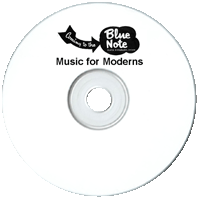

Featuring Chicago Jazz which was generally more sophisticated than New Orleans and the Dixieland sound but placed a stronger emphasis on individual improvisation.

13 old time radio show recordings
(total playtime 5 hours, 28 min)
available in the following formats:
1 MP3 CD
or
7 Audio CDs
Text on OTRCAT.com ©2001-2025 OTRCAT INC All Rights Reserved. Reproduction is prohibited.


Chicago Jazz would experience a renaissance which would come to full bloom during the Fifties (and continues to this day) at a club at 45 West Madison Street, near Dearborn, called the Blue Note which was opened by Frank Holzfeind. Frank had given up on his own musical career years before, but his love for Jazz would help the art form to hang on and expand into the Twenty-first century. Holzfeind (rhymes with "find", not "fiend") came to Chicago from his native Milwaukie in 1920 with a buck and a half in his pocket, four-bits of which went towards a room at the YMCA. He got a job as a machinist but the factory closed down, so he got on as a brush salesman. "My customers used brushes primarily for two things: scrubbing whiskey bottles and toilet bowls. I was known as the company specialist in those fields. They weren't the same brushes, of course."
From brush sales, Frank transitioned to a clerking job with the Chicago and Northwestern Railway. He stayed with the railroad for more than twenty years but never seemed content with a desk job. He sidelined by starting a newsletter for the company bowling league and wrote a pamphlet on Public Speaking for Railroaders. In 1942, he was offered the chance to manage a bowling alley. There was a tavern attached to the lanes, and Holzfeind hired Jazz pianists to play on occasion. The bowling alley burned to the ground in 1945, but Frank and the owner were able to save more than 1000 bottles of booze before the end. That hooch would become the basis for the new club at 56 Madison.
While looking for new Jazz talent for the Blue Note, Frank became friends with late-night radio personality Dave Garroway. Garroway helped to expand Holzfeind's musical appreciation and became a regular at the Blue Note. The club was named for the watering hole frequented by Front Page Farrell on the radio. Jazz greats who graced the Blue Note Stage included Louis Armstrong, Maxine Sullivan, Dizzy Gillespie, Charlie Ventura, Slim Gaillard, George Shearing, Duke Ellington, Lionel Hampton, Erroll Garner, Bob Scobey and Jack Teagarden. In 1953, NBC began a series of remote broadcasts from the Blue Note called Music For Moderns The show featured Dizzy Gillespie, Marian McPartland, the Dave Brubeck Quartet, and several others.
According to people who knew the Blue Note, Holzfeind's fatal flaw was that he was a music lover first and a businessman later, if at all. The Chicago Jazz renaissance he helped to spark became his downfall. It was said that Frank was as good to his audiences as he was his musicians, but as the acts became more expensive he refused to raise his prices and had to fold in 1960.
Text on OTRCAT.com ©2001-2025 OTRCAT INC All Rights Reserved. Reproduction is prohibited.
You have reached the maximum number of votes for a unregistered user.
Please login or create a new account to continue...
You have reached the maximum number to down votes in this page.



Music for Moderns Disc A001
|
Add Audio CD to Cart - $5.00 |
Music for Moderns Disc A002
|
Add Audio CD to Cart - $5.00 |
Music for Moderns Disc A003
|
Add Audio CD to Cart - $5.00 |
Music for Moderns Disc A004
|
Add Audio CD to Cart - $5.00 |
Music for Moderns Disc A005
|
Add Audio CD to Cart - $5.00 |
Music for Moderns Disc A006
|
Add Audio CD to Cart - $5.00 |
Music for Moderns Disc A007
|
Add Audio CD to Cart - $5.00 |
Please wait...
COMMENTS
Be the first to comment on "Music for Moderns"
Leave a comment